The $60 CPU Question: AMD Athlon 200GE or Intel Pentium Gold G5400? A Review
by Ian Cutress on January 14, 2019 8:00 AM ESTCPU Performance: Office Tests
The Office test suite is designed to focus around more industry standard tests that focus on office workflows, system meetings, some synthetics, but we also bundle compiler performance in with this section. For users that have to evaluate hardware in general, these are usually the benchmarks that most consider.
All of our benchmark results can also be found in our benchmark engine, Bench.
PCMark 10: Industry Standard System Profiler
Futuremark, now known as UL, has developed benchmarks that have become industry standards for around two decades. The latest complete system test suite is PCMark 10, upgrading over PCMark 8 with updated tests and more OpenCL invested into use cases such as video streaming.
PCMark splits its scores into about 14 different areas, including application startup, web, spreadsheets, photo editing, rendering, video conferencing, and physics. We post all of these numbers in our benchmark database, Bench, however the key metric for the review is the overall score.

As an all-around test, one hopes that PCMark should be able to shine a light into this analysis. The end result is that PCMark says Intel should be ahead by around 8%.
Chromium Compile: Windows VC++ Compile of Chrome 56
A large number of AnandTech readers are software engineers, looking at how the hardware they use performs. While compiling a Linux kernel is ‘standard’ for the reviewers who often compile, our test is a little more varied – we are using the windows instructions to compile Chrome, specifically a Chrome 56 build from March 2017, as that was when we built the test. Google quite handily gives instructions on how to compile with Windows, along with a 400k file download for the repo.
In our test, using Google’s instructions, we use the MSVC compiler and ninja developer tools to manage the compile. As you may expect, the benchmark is variably threaded, with a mix of DRAM requirements that benefit from faster caches. Data procured in our test is the time taken for the compile, which we convert into compiles per day.
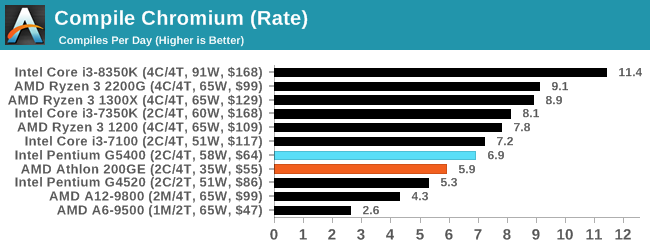
I like this Chromium test, given that it probes a lot of areas within a system. The Intel G5400 wins here again, scoring 6.9 compiles per day, compared to 5.9 for the AMD 200GE.
3DMark Physics: In-Game Physics Compute
Alongside PCMark is 3DMark, Futuremark’s (UL’s) gaming test suite. Each gaming tests consists of one or two GPU heavy scenes, along with a physics test that is indicative of when the test was written and the platform it is aimed at. The main overriding tests, in order of complexity, are Ice Storm, Cloud Gate, Sky Diver, Fire Strike, and Time Spy.
Some of the subtests offer variants, such as Ice Storm Unlimited, which is aimed at mobile platforms with an off-screen rendering, or Fire Strike Ultra which is aimed at high-end 4K systems with lots of the added features turned on. Time Spy also currently has an AVX-512 mode (which we may be using in the future).
For our tests, we report in Bench the results from every physics test, but for the sake of the review we keep it to the most demanding of each scene: Cloud Gate, Sky Diver, Fire Strike Ultra, and Time Spy.
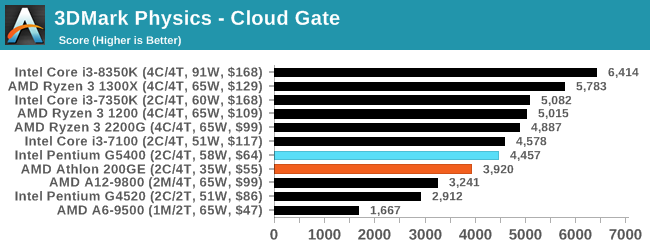
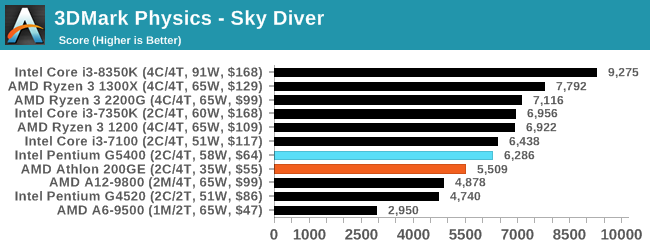
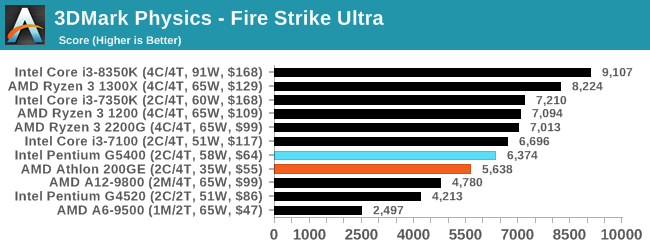
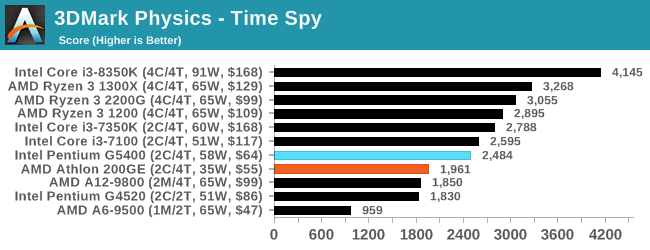
In all the tests except Time Spy, Intel takes an 11-12% lead over AMD, while in Time Spy that increases to 20%.
GeekBench4: Synthetics
A common tool for cross-platform testing between mobile, PC, and Mac, GeekBench 4 is an ultimate exercise in synthetic testing across a range of algorithms looking for peak throughput. Tests include encryption, compression, fast Fourier transform, memory operations, n-body physics, matrix operations, histogram manipulation, and HTML parsing.
I’m including this test due to popular demand, although the results do come across as overly synthetic, and a lot of users often put a lot of weight behind the test due to the fact that it is compiled across different platforms (although with different compilers).
We record the main subtest scores (Crypto, Integer, Floating Point, Memory) in our benchmark database, but for the review we post the overall single and multi-threaded results.
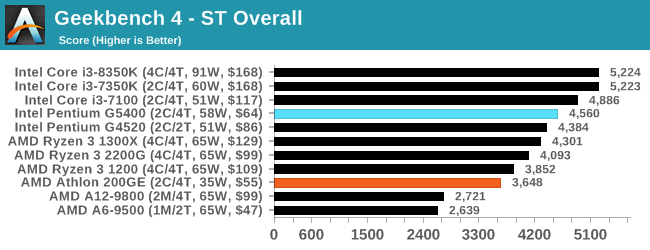
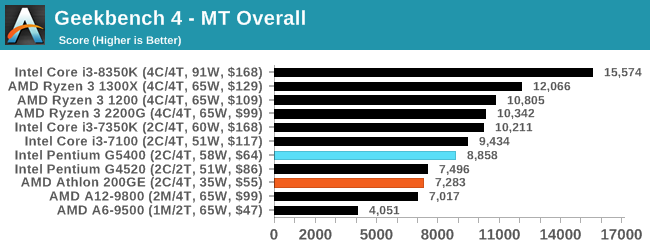










95 Comments
View All Comments
Irata - Tuesday, January 15, 2019 - link
Curious - which Retailer ?Valantar - Tuesday, January 15, 2019 - link
The difference in Norway is slightly larger, with 599NOK for the 200GE vs. 729 for the G5400 - but it's not in stock anywhere, so prices may be fictitious (or there's no supply at all). 200GE supply seems plentiful.andrewaggb - Tuesday, January 15, 2019 - link
I liked the article. I was interested in the 200GE's performance for some headless budget builds and now I know where it sits.I wouldn't use either of these chips on even a budget gaming build. Get a 2200g or i3 8100+ for gaming.
darb - Wednesday, January 16, 2019 - link
On page 3, is "Uses might ask why we are not running Windows 10 x64 RS4, the latest major update" supposed to be "Users might ask why..."?Stuka87 - Wednesday, January 16, 2019 - link
Under gaming with the World of Tanks results, it says GTX1080, but then also has an IGP column, and the IGP column is higher than everything else? Also, Encore engine was released last year, and WoT has been using it since April. So it is no longer "unreleased".GreenReaper - Thursday, January 17, 2019 - link
I think the idea is that it is "IGP"-level *settings*, run on the video card. It's a tad confusing, I agree.just4U - Wednesday, January 16, 2019 - link
I always find it fun to compare budget processors to yesteryear's high end to see where you land up.. It almost looks like this is in the range of a low end 4000 series i5 and a bit better than it's i3 variants. Hmm.. 2 cores though ugh. I'd probably want at least 4.GreenReaper - Thursday, January 17, 2019 - link
It's worth if you can possibly afford it. About the only other situation I see it making sense *not* to is if power or cooling is a major consideration (especially if hyperthreading works for you). My server is just fine on two cores, and that reduces its power and cooling requirements, which have a 35W limit.Death666Angel - Wednesday, January 16, 2019 - link
I sent you a tweet about the lables in the GTX1080 section and then realised I misread it. Deleted the tweet. Oh well. Good conclusion overall, very fair. Aligns perfectly with what I would do.Unfortunately, here (Germany) as well, the Intel CPUs are way overpriced. For a G5400 I can get a Ryzen 3 2200G. So it all kinda falls apart because of the weird CPU shortage.
Manch - Friday, January 18, 2019 - link
Would this be good for a NAS?